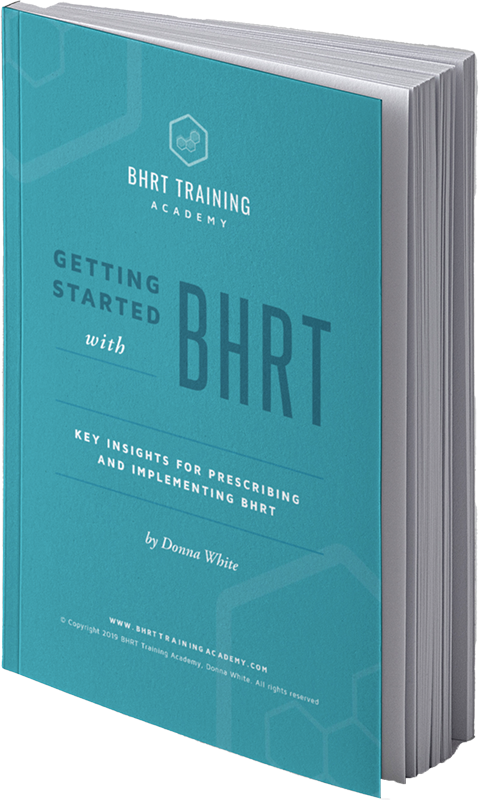How to Get Started With BHRT: Four Key Components of Comprehensive BHRT Training

If you’ve decided to add Bioidentical Hormone Replacement Therapy as a complement to your medical practice, congratulations. BHRT is a profitable, high demand therapy that is a valuable service for any practice. It’s also a beautiful addition to plastic surgery and other aesthetic medical practices.
But before you get started with BHRT, there are some basics you need to have covered, and comprehensive BHRT training that covers four key components is essential to a successful BHRT practice.
How to Get Started With BHRT: Four Key Components of Comprehensive BHRT Training
First Key Component – BHRT Foundational Education
The first thing you need to have to get started with BHRT is a strong foundation in the scientific validation behind this modality. You need to be well-versed on important studies concerning BHRT, so you can confidently recommend, substantiate, and implement bioidentical hormones into your practice model.
After reviewing the literature, you will be truly impressed at the vast amount of research that has been done on bioidentical hormone use, dating back to the 1970s. Research has even been done comparing bioidenticals to non-bioidenticals.
Second Key Component – BHRT Assessment Techniques
When you get started with BHRT you need to learn how to identify and assess patients for hormone imbalances which might make them ideal candidates for this therapy. These imbalances are identified by recognizing symptoms and ordering the appropriate lab testing. Then, using a combination of lab results in conjunction with a review of the patient’s symptoms and history, you can effectively direct the necessary protocols and a treatment plan that will achieve the optimal results for your patient.
To help you identify symptoms, here is a symptoms chart adapted from the BHRT Providers Training Manual provided for students of the BHRT Training Academy.
Hormone testing not only assists practitioners in detecting hormone imbalances, but it also helps monitor dosing and supports increased patient compliance and understanding. When testing for endogenous hormone levels (prior to replacement therapy), providers can choose between serum, saliva, capillary blood spot, 24-hour urine, and dried urine hormone testing. However, it’s important to keep in mind that different testing methodologies offer varying benefits and limitations. To monitor replacement therapy, it is important to use the appropriate method of testing based on the dosing form the patient is taking and the parameters the provider wants to measure.
Lastly, due to the intricate interactions of hormones, it is critical that testing is inclusive of the sex hormones, adrenal hormones, and thyroid hormones.
Third Key Component – BHRT Application Strategies
To get started with BHRT you need first to have an in-depth understanding of hormones, their actions, and effects in the body, and precisely how to prescribe them.
It’s important to note that comprehensive BHRT training must include education on adrenal hormones, thyroid hormones as well as insulin and glucose metabolism. This is because no hormone works in isolation. They are like a symphony that must all be in tune to play beautiful music.
Once you’re feeling very confident in your understanding of the hormones, you will need to learn the different dosing forms and how to prescribe and monitor them. Bioidentical hormones are available in several different prescribable forms such as:
- pills
- creams
- gels
- vaginal tablets or creams
- patches
- pellets
In addition to BHRT prescriptions, hormone balancing also requires supplements, dietary changes, and lifestyle modification measures.
The best part about learning about all this information is that it is so fascinating! In the 20 years I’ve been teaching this material, I can tell you first hand that you will be hooked on hormones. The more you learn the more you will want to know.
Bioidentical Hormone Replacement Therapy can be a profitable, rewarding addition to your practice. Read this post to learn how the anti-aging industry is one of the fastest-growing industries on the planet.
Fourth Key Component – BHRT Implementation Procedures
To get started with BHRT and treating patients at your practice, you’ll first need to work through an implementation plan for integrating this therapy into your current practice. Or maybe you want to set up a brand new practice. Here are some important things to consider when you are setting up your practice:
- Consultation procedures – what to do at each visit, how often to see patients, which labs to order from
- Treatment plans – protocols for hormones, supplements, and dietary measures for issues and conditions related to hormone imbalance
- Administration – required forms or electronic health record system, consent forms, patient education materials, laboratory and supplement accounts
Since BHRT is not taught in medical schools, providers have to be willing to invest the time themselves to learn this modality. BHRT is definitely not a one dose fits all solution like traditional HRT or birth control pills.
It requires purposeful decision making by a proactive, knowledgeable doctor. In order to get started with BHRT, you need to be capable of assessing each individual patient’s needs, history, lab results, health goals, symptoms, and more. But this is why BHRT is such a rewarding and fascinating practice!
Ready to learn more about how BHRT could fit into your practice? Click here to schedule a strategy call and get started.
Enjoyed this article? Here are three more to help you:
Four common types of hormonal imbalance: perimenopause/PMS
What is BHRT? Five basics to help you talk to your patients.

Get the quick read ebook,
Getting Started with BHRT -
Key Insights to Prescribing and Implementing BHRT.
CME's - Earn while you learn.
